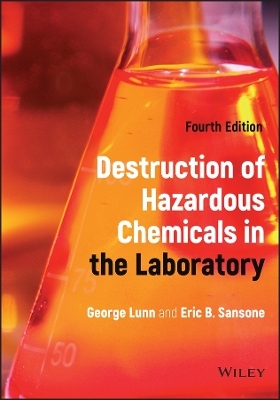
Destruction of Hazardous Chemicals in the Laboratory
John Wiley & Sons Inc (Verlag)
978-1-119-84880-6 (ISBN)
- Lieferbar
- Versandkostenfrei
- Auch auf Rechnung
- Artikel merken
Destruction of Hazardous Chemicals in the Laboratory is a practical reference that describes procedures for the destruction of a comprehensive list of hazardous chemicals and provides general methods for the destruction of hazardous chemicals in the laboratory without the need for exotic reagents and equipment.
Unlike most other sources on this subject, detailed reaction parameters are provided to readers. These details will help the reader decide if a procedure will be appropriate. To further aid in reader comprehension, numerous tables throughout the book allow for ready comparison of procedures.
Destruction of Hazardous Chemicals in the Laboratory also describes the critical aspects of various protocols (e.g., UV lamp type and rate of ozone flow).
The updated fourth edition Includes an updated survey of the literature from 2012-2021 and features data mined from 1,500 papers. It also describes recent examples of methods that are generally applicable to organic compounds and greatly expands the section on methods for the destruction of pharmaceuticals in the laboratory.
In this book, readers can expect to find detailed information on:
Specific methods for the destruction of hazardous chemicals in the laboratory, such as aflatoxins, butyllithium, complex metal hydrides, ethidium bromide, MPTP, nitrosamines, and polycyclic aromatic hydrocarbons
Methods for the destruction of pharmaceuticals in the laboratory, such as those using ozone, persulfate, and potassium permanganate as well as photolytic degradation procedures
Procedures for drying organic solvents
A discussion of the issues concerning nitrosamine formation during the destruction process, particularly when sodium hypochlorite is used
A variety of indexes, including a general index, cross index of pharmaceuticals and destruction procedures, cross index of dyes and destruction procedures, and cross index of names for dyes and biological stains
Destruction of Hazardous Chemicals in the Laboratory is of immense value to researchers in the laboratory by enabling them to quickly and efficiently get rid of residual amounts of hazardous chemicals when a series of experiments has ended. The procedures in the text can also be incorporated into laboratory protocols.
George Lunn, Ph.D., has been working as a review chemist for the FDA’s Office of Pharmaceutical Quality since 1996. Previously he was a senior research scientist in the Environmental Control and Research Program at the NCI-Frederick Cancer Research and Development Center. Eric B. Sansone, Ph.D., was the director of the Environmental Control and Research Program at the NCI-Frederick Cancer Research and Development Center until his retirement.
Preface xi
Acknowledgments xiii
Introduction 1
Safety considerations 9
Nitrosamine Formation 12
Sodium Hypochlorite 15
Nickel–Aluminum Alloy 18
Potassium Permanganate 19
Specific Methods for the Destruction of Hazardous Chemicals in the Laboratory 25
Acetonitrile 27
Acid Halides and Anhydrides 31
Aflatoxins 35
Alkali and Alkaline Earth Metals 43
Alkali Metal Alkoxides 47
Anatoxin-A 49
Aromatic Amines 53
Arsenic 61
Azides 65
Azo and Azoxy Compounds and Tetrazenes 73
Boron Trifluoride and Inorganic Fluorides 79
Botulinum Toxins 83
Brevetoxins 87
Butyllithium 91
Calcium Carbide 95
Carbamic Acid Esters 97
Carbofuran 101
Chloromethylsilanes and Silicon Tetrachloride 103
N-Chlorosuccinimide and Chloramine-T 105
Chlorosulfonic Acid 107
Chromium(VI) 109
Citrinin 115
Complex Metal Hydrides 123
Cyanides and Cyanogen Bromide 129
Cylindrospermopsin 137
Diisopropyl Fluorophosphate 141
Dimethyl Sulfate and Related Compounds 149
Dyes and Biological Stains 161
Ethidium Bromide 195
Haloethers 203
Halogenated Compounds 207
Halogens 223
Heavy Metals 227
Hexamethylphosphoramide 233
Hydrazines 235
Hypochlorites 247
Mercury 251
2-Methylaziridine 257
1-Methyl-4-phenyl-1,2,3,6-tetrahydropyridine (MPTP) 261
Microcystins 265
4-Nitrobiphenyl 275
3-Nitrofluoranthene and 3-Aminofluoranthene 277
Nitrogen Tetroxide 281
N-Nitroso Compounds: Nitrosamides 283
N-Nitroso Compounds: Nitrosamines 295
Ochratoxin A 307
Okadaic Acid 315
Organic nitriles 319
Osmium tetroxide 321
Palytoxin 323
Patulin 327
Peracids 333
Perchlorates 335
Peroxides and Hydroperoxides 339
Phenol 343
Phosgene 347
Phosphorus and Phosphorus Pentoxide 351
Picric Acid 355
Polycyclic Aromatic Hydrocarbons 357
Polycyclic Heterocyclic Hydrocarbons 367
Potassium Permanganate 381
β-Propiolactone 383
Protease Inhibitors 385
Ricin 389
Saxitoxin 393
Selenium Compounds 397
Sodium Amide 399
Sterigmatocystin 401
Sulfonyl Fluoride Enzyme Inhibitors 407
Sulfur-Containing Compounds 413
T-2 Toxin and Other Tricothecenes 419
Tetrodotoxin 425
Triacetone Triperoxide 429
Uranyl Compounds 433
Destruction of Pharmaceuticals 437
General Considerations 439
Potassium Permanganate 451
Nickel–Aluminum Alloy Reduction 467
Fenton Reaction 473
Hydrogen Peroxide 479
Ozone 481
Ferrate 497
Persulfate 505
Hydrogen Peroxide and Horseradish Peroxidase 513
Specific Degradation Procedures for ß-Lactams 515
Decontamination of Aqueous Solutions 517
Miscellaneous Chemical Degradation Procedures 523
General Considerations for Photolytic Procedures 535
Photolysis Without Added Reactants (UV Only) 537
Photolysis with Hydrogen Peroxide (UV/H2O2) 555
Photo-Fenton Reaction 573
Photolysis with Titanium Dioxide (UV/TiO2) 589
Photolysis with Zinc Oxide (UV/ZnO) 605
Photolysis with Ozone (UV/O3) 609
Photolysis with Persulfate (UV/Persulfate) 615
Photolysis with Chlorine (UV/Cl2) 631
Miscellaneous Photolytic Procedures (UV/Miscellaneous) 643
Procedures Classified by Method 649
General Considerations 651
Potassium Permanganate 655
Fenton Reaction 659
Ozone 667
Persulfate 677
Miscellaneous Procedures 683
Photolysis Without Added Reactants (UV only) 691
Photolysis with Hydrogen Peroxide (UV/H2O2) 697
Photo-Fenton Reaction 707
Photolysis with Titanium Dioxide (UV/TiO2) 715
Photolysis with Zinc Oxide (UV/ZnO) 727
Photolysis with Ozone (UV/O3) 735
Photolysis with Persulfate (UV/Persulfate) 741
Photolysis with Chlorine (UV/Cl2) 747
Biologicals 751
Appendixes 777
Appendix I: Procedures for Drying Organic Solvents 779
Appendix II: Safety Considerations With Potassium Permanganate 783
Cross-Index of Names for Dyes and Biological Stains 791
Cross-Index of Methods Used for Specific Dyes and Biological Stains 813
Cross-Index of Methods Used for Pharmaceuticals 817
Name Index 837
| Erscheinungsdatum | 12.01.2023 |
|---|---|
| Verlagsort | New York |
| Sprache | englisch |
| Gewicht | 1855 g |
| Themenwelt | Naturwissenschaften ► Chemie ► Technische Chemie |
| Technik | |
| ISBN-10 | 1-119-84880-6 / 1119848806 |
| ISBN-13 | 978-1-119-84880-6 / 9781119848806 |
| Zustand | Neuware |
| Informationen gemäß Produktsicherheitsverordnung (GPSR) | |
| Haben Sie eine Frage zum Produkt? |
aus dem Bereich


